Grandinote Domino pre and Demone mono amps

 Grandinote Audio is an high-end audio company that’s been making heads turn lately. Founded in 1993 by talented designer and electrical engineer Massimiliano Magri, his eight-person company is located in the quaint, sleepy province of Lombardy, about thirty miles south of Milan. Few audiophiles on this side of the Atlantic have had the opportunity to hear Grandinote products. It is my good fortune to have done so – under challenged listening conditions – I found the performance of their products quite extraordinary. They are Class-A, solid-state designs that, in many ways, sound like single-ended vacuum tube amplifiers except with dynamics and authority unlike any SE tube design I’ve heard.
Grandinote Audio is an high-end audio company that’s been making heads turn lately. Founded in 1993 by talented designer and electrical engineer Massimiliano Magri, his eight-person company is located in the quaint, sleepy province of Lombardy, about thirty miles south of Milan. Few audiophiles on this side of the Atlantic have had the opportunity to hear Grandinote products. It is my good fortune to have done so – under challenged listening conditions – I found the performance of their products quite extraordinary. They are Class-A, solid-state designs that, in many ways, sound like single-ended vacuum tube amplifiers except with dynamics and authority unlike any SE tube design I’ve heard.
My first encounter with Grandinote Audio was in the late spring of 2012 at the High End show in Munich. Extreme Audio’s Aldo Zaninello was very excited over a new Italian-built planar-ribbon loudspeaker he was closely involved with, the Leonardo Audio Model 8. At his insistence, I traveled with him from the M.O.C to a Holiday Inn nearby. He said it had a much larger space that would prove memorable for a first-time encounter with the Model 8s. What he did not know was that this would also be my first encounter with Grandinote Audio.

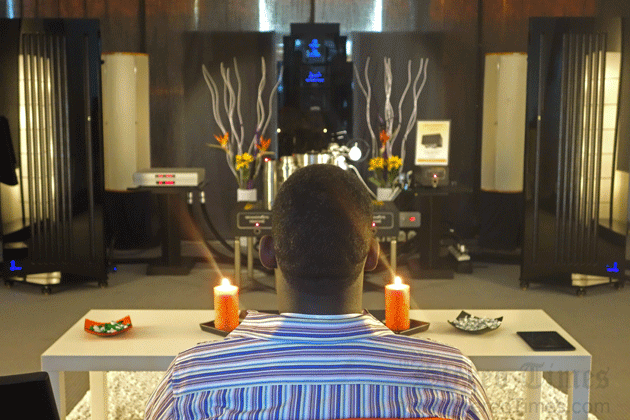
In my subsequent Stereotimes report I wrote: “If you too admire or hold a fondness for electrostats or ribbon-planars, then you know they possess a sound devoid of colorations that plague conventional (box) designs. The upside is usually more truthful timbre accuracy and a transparent window into the music. The Achilles heel has always been surrounding the lack of bass weight, authority or dynamics. Moreover, historically low sensitivity ratings allow for only the most prodigious of amplifiers. Newer designs, such as the Analysis Audio loudspeaker, have gained great strides in respect to improved sensitivity and overall bass quality, but I still wouldn’t compare its bass accuracy or dynamics to the best available in a box design. The Leonardo was the first planar-ribbon I have ever heard that could match the very best box enclosure in dynamic scale, bass impact and authoritative weight… The dipole effect gave a sense of articulation and roundness that was unlike anything I have experienced in a line source. It was unbelievably coherent…. So good in fact was the Leonardo’s bass output, I doubt if I have ever heard any speaker regardless of design relay this level of coherency in the lowest octaves matched so well to its midrange and high-frequencies. The Leonardo acts and sounds like a huge single source device… The bass was so overwhelming and powerful, it actually became too much of a good thing on certain songs. If this sounds like an absolute rave, well I guess it is. I have no other way of stating what I heard.”Not a single mention of the Grandinote electronics driving the Leonardos. Not one. (My apologies, Max.) All my attention was on the spectacular sound of the loudspeakers—as if they were self-powered!
Looking back, I realize I reported only half of the truth. For only a few months later I discovered that Grandinote amplification had more to do with the sound than I would have ever believed possible.
Later that year my wife, Monique, and I vacationed in Venice and while there we visited Extreme Audio’s factory, about an hour’s drive north. We saw a pair of Leonardo planar-ribbon loudspeakers being hand-crafted. We also had the opportunity to listen at length to both the Leonardos and the uniquely sculpted Sigma Acoustics’ 2.3 Orchestra loudspeakers, powered by some very interesting electronics including the gigantic, tubed KR Audio amplifier, some older model Levinson mono amps and a Grandinote 37 watt Essenza. The listening room was very nicely sized (about 20′ by 25′ with 12′ ceiling). We listened first to the Leonardos with the KR amp (I forget which model). The sound was liquid with great image density and front to back soundstaging. I wasn’t sure the sound was as well propelled into the room as it had been in Munich with the 60-watt Grandinote Demone monoblocks and Proemio preamplifier. I liked the sound overall, but I felt that there was something more to be had from this setup. Maybe Aldo would swap out the KR’s for the little Grandinote Essenza (despite the widely accepted “fact” that tubes outperform solid-state driving a planar-ribbon loudspeakers)?
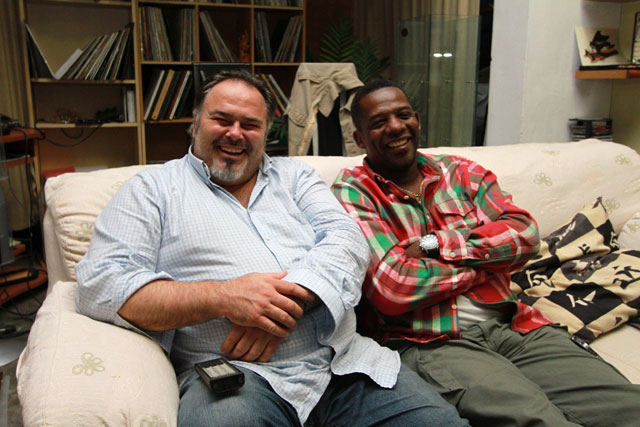

When he made the switch I heard the difference right away: the bass was quicker in response, more agile and more energetic. The midrange was cleaner, crisper and more well focused, while imaging had greater specificity on the outer edges of the soundstage. I sat there slack jawed that this oddly-shaped, utilitarian solid-state device actually possessed more presence and overall musicality than a world-class tube design—driving a planar-ribbon loudspeaker! When swapped out the Leonardo for the Sigma Acoustics’ Orchestra, it became even more apparent that the little Essenza, with its glorious 37 watts, was extraordinarily different from any other medium-power solid-state amplifier I knew.
I returned from our trip to Venice with Grandinote as much on my mind as the beauties of that vibrant Renaissance city. Unfortunately, Grandinote was not at that time represented in the USA, so getting a review sample was impossible.
The following year, 2013, I confirmed my impression of the year before at the High End show. Once again the Grandinote room proved to be such a standout, it had me returning several times a day. Then, not hearing about the company for the next few years, I assumed that the Grandinote had fallen through the cracks of high-end audio’s “beauty-contest” mentality.
Enter Fred Crane of Audioprana.
Can’t quite remember how I first met Fred, but I’m very glad I did. Not only because he imports hard-to-find European audio products like Gobel, Audionec, Boenicke, SoulSonic, Rockna, Trafomatic and Hemingway to his Massachusetts showroom, but also because he’s the sole USA importer of Grandinote! When Crane suggested coming over to my place for a listening session WITH GRANDINOTE ELECTRONICS, I was elated! Not simply because I had finally gotten a review sample after a five year wait, but because someone else had heard what I did through Grandinote electronics.
Some weeks later, as promised, Crane drove from Boston to my Jersey City home with three nicely sized boxes in the trunk of his SUV. These housed Grandinote Demone monoblocks and the partnering Domino preamp. The unprepossessing Grandinotes gave a “what the hell are those” impression in my downstairs dining room, particularly with a pair of odd-looking Soundkaos Wave 40 loudspeakers.
Grandinote “Magnetosolid VHP technology” is a solid-state, zero-feedback, pure class-A design employing hand-made ferromagnetic sources with high-output transformers and specialized resistors. “Independent and dedicated power supplies are used for each device while there are no capacitors in the signal path.” says designer Massimiliano Magri. This, he says, is what gives the Grandinote the ability to offer much of what tube owners cannot live without: harmonic richness and a natural tone that flows effortlessly from a three-dimensional plane.
Grandinote also boasts what we solid-state guys crave: incredible grip on the lower octaves coupled with speed that gives the music more than mere transparency, a see-through quality that’s rare in a solid-state device. Massimiliano related that he started Grandinote in 1993 using vacuum tubes, but created a more stable and dynamic design in 2005 when he switched to solid-state.
.jpg?KeepThis=true&TB_iframe=true&height=430&width=700)
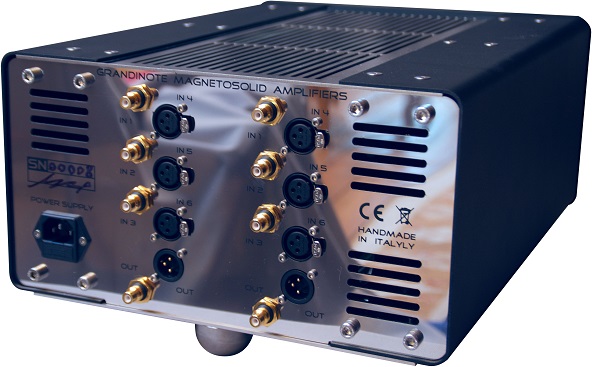
The Grandinote Domino preamplifier was the company’s flagship design until recently, when the Genesi was released. (I hope to get a review sample before the end of the year.) Also true class-A, dual-mono, zero-feedback architecture, the Domino uses direct coupling with no capacitors in its signal path. As Magri said, “…it’s clean, tight, delightfully open, yet natural and easy flowing.” The preamp, like the rest of the Grandinote designs, has a chassis that is longer front to back than side to side. The front panel window employs red LEDs and is legible from my listening seat eight feet away. Volume and Mute are controlled by Up and Down buttons on the front panel or by remote control. Input selection is handled on the left front panel and by remote. Programming allows you to set each of the six Inputs to a desired volume setting. The rear of the Domino supports both XLR and RCA inputs (three each) as well as XLR and RCA outputs.
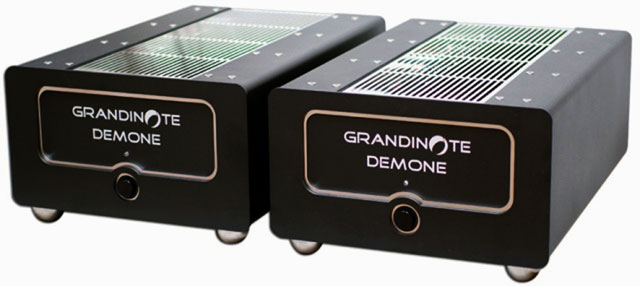
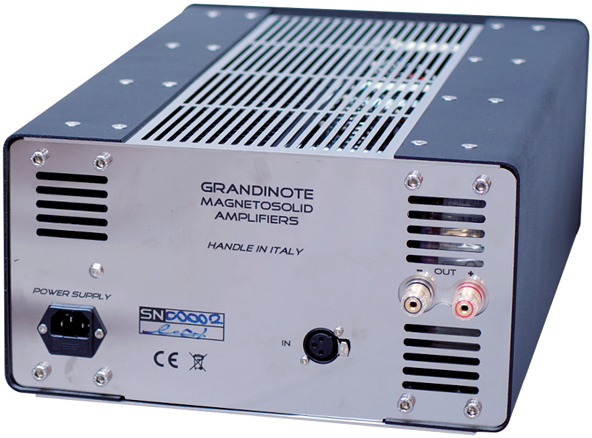
The Grandinote Demone monoblocks weigh 66 lbs each. They have a partially ventilated aluminum top (class-A designs generate a lot of heat). The bottom is supported by three feet instead of the usual four. The rear of the Demone has a single XLR input, a male IEC, and speaker binding posts. “GRANDINOTE MAGNETOSOLID AMPLIFIERS and Handle in Italy” (instead of “Hand Made in Italy”) is inscribed on the back along with a unique serial number. My one gripe about the Grandinote is its front: the white lettering Grandinote Demone on the black metal chassis is unattractive, making this one of the few Italian products I’ve seen that aren’t drop-dead gorgeous. (The face plate can be ordered with different colored lettering.)
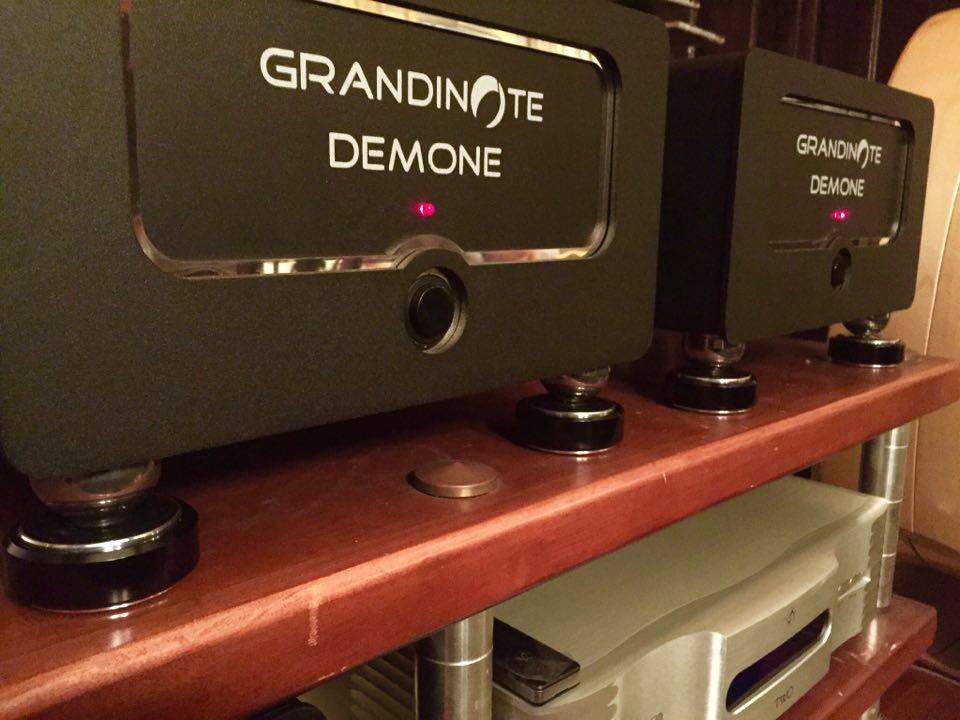
Listening to Graninote electronics with my Sooloos music server and Soundkaos Wave 40 loudspeakers resulted in a wonderful, sweet sounding synergy, with far more expression and dynamic contrast than when driven by the New Audio Frontiers 300B integrated that I raved about in a previous review (here). Amplifier power has great effect on the performance of a loudspeaker but let me assure you that the 21 watts created by the NAF 300B is a horse of a different color, with greater resolution than even the G9 Audio 120 monoblocks. I mention these units because the Grandinote combo possessed a little bit of what I so admired in these two distinctly different amplifiers. At 60 watts per channel, the Grandinotes have a greater command of the bass region with cleaner delineation of the upper bass than both the G9 and the NAF.
Usually, when someone says “cleaner” it implies less color and harmonic richness. But that’s not the case with the Grandinotes. The sound is infused with a rich a color palate and a natural saturation of harmonics, almost to the point where you might think they are a hybrid design. No sir, they are not.
 On the other side of the sonic landscape, its upper-frequency excellence is delivered with a sense of vitality that surpasses tube designs. For example, listening to Joni Mitchell’s introspective interpretation of “Both Sides Now,” from her album of the same name (released in 2000), offers some remarkably well-recorded arrangements, especially with regard to strings. The Grandinote combo lifted this part of the recording to even higher heights and with a tad more resolution, presence and focus than I remembered from the NAF integrated (which was my former best on this particular recording). The sense of spatiality and overall weightiness also was improved upon but never intrusive. In certain parts of the song, the music unobtrusively swelled up and just as suddenly went back to whisper quiet.
On the other side of the sonic landscape, its upper-frequency excellence is delivered with a sense of vitality that surpasses tube designs. For example, listening to Joni Mitchell’s introspective interpretation of “Both Sides Now,” from her album of the same name (released in 2000), offers some remarkably well-recorded arrangements, especially with regard to strings. The Grandinote combo lifted this part of the recording to even higher heights and with a tad more resolution, presence and focus than I remembered from the NAF integrated (which was my former best on this particular recording). The sense of spatiality and overall weightiness also was improved upon but never intrusive. In certain parts of the song, the music unobtrusively swelled up and just as suddenly went back to whisper quiet.
The Grandinote combo presents a sense of scale that is far more powerful than their 60 watt rating would imply. Their control and overall grace during loud passages is impressive. None of that ever-so slight sense of strain on any recording I played. With the music opening up so freely and effortlessly, there was hardly ever any need for loud volume levels. Joni’s voice is heavier and more mature in this 2000 recording. Certainly moreso than in her previous dates. The Grandionote allows one to appreciate this by getting out of the way and allowing Joni to display her amazing talent. It sounded just right.
 Equally haunting was Rickie Lee-Jones’s 1991 stellar CD “Pop Pop,” especially Coming Back to Me. On this track the Grandinote combo’s innate ability to present transparency coupled with body and richness is beyond anything the Soundkaos Wave 40’s have produced thus far. Poise is a word that showed up over and over in my notes. This song shows off Rickie Lee-Jones’s voice in a way that is striking but perhaps difficult to fully appreciate until the volume is spot on at the perfect loudness. The trick on this song is to not play it too loud or too quiet.
Equally haunting was Rickie Lee-Jones’s 1991 stellar CD “Pop Pop,” especially Coming Back to Me. On this track the Grandinote combo’s innate ability to present transparency coupled with body and richness is beyond anything the Soundkaos Wave 40’s have produced thus far. Poise is a word that showed up over and over in my notes. This song shows off Rickie Lee-Jones’s voice in a way that is striking but perhaps difficult to fully appreciate until the volume is spot on at the perfect loudness. The trick on this song is to not play it too loud or too quiet.
The Grandinote combo has remarkable low-level transparency, enough to render Rickie Lee-Jones’s lyrics with uncanny intelligibility at very low volume settings. This allows for dynamic contrasts that are not available in lesser designs. Moreover, it made this legendary recording that much more heartfelt. Another great song is Dat Dere, and although this song is on a Burmester sampler disc and I’ve heard it many times on many different systems in many different rooms, I was struck by the rhythm and coherency of the bass notes, the sparkling top-end and the overall synergy the Grandinote combo seemed to glean from this song.
I can go on and on detailing the musical highlights the Grandinotes brought forth again and again. In many ways, they’re among the best solid-state devices I have ever heard. The friends who visit my home and whose ears I trust have mentioned this same sentiment to me after only a few short sessions.
What I think separates Grandinote from the usual lot of amplifiers I’ve heard is their acuity at presenting proper tonal shadings and harmonics, often slightly bleached-sounding in other solid-state designs. At the same time, they possess a level of transparency, bass control and authority that isn’t commonplace. That, in and of itself, makes Grandinote unique and among the very best and musically satisfying designs to have graced my listening space. At $45,000 and $15,000 respectively, they are not inexpensive. However, they do things for planar-ribbon loudspeakers and moderately efficient dynamic designs that I haven’t heard matched by other well-known, and even more expensive, designs.
Hopefully, given time and adequate advertising by Audioprana, the truth about Grandinote designs will become well known here in the USA. If the price is above your budget, the small 37-watt Essenza integrated will serve as a worthy alternative. However, I’m keeping the Grandinote Demone and Domino combination based solely on their remarkable sonic excellence and I can hardly wait for the arrival of the newer, improved Genesi preamplifier. I highly recommend Grandinote. 

clement perry
Specifications:
Demone preamplifier
Price: $15,000
Three unbalanced inputs RCA
Three balanced inputs XLR (full-balanced)
Balanced inputs XLR unbalanced convertibles
One balanced output XLR (full-balanced)
Frequency response 1,3Hz – 400 kHz
Gain = 10 dB
Class “A”
No feedback
Direct coupling stages: no capacitor used
Full-dualmono
Absorption 30W
Weight 16kg
W=318 x H=196 x L=408 [mm]
Grandinote’s warranty of 5 years
Specifications:
Demone Monophonic power amplifier
Price: $45,000.00/pr
Nominal power 60W
Damping factor >230
Frequency response 1,5Hz – 350 kHz
One balanced input XLR (full balanced)
Class “A”
No feedback
Direct coupling stages: no capacitor used
Absorption 220W (each channel)
Weight 30kg (each channel)
W=318 x H=196 x L=473 [mm] (each channel)
Magnetosolid-VHP
USA Importer: Audioprana
Contact: Fred Crane
Website: www.audioprana.info/contact/
Stereo Times Masthead
Publisher/Founder
Clement Perry
Editor
Dave Thomas
Senior Editors
Frank Alles, Mike Girardi, Key Kim, Russell Lichter, Terry London, Moreno Mitchell, Paul Szabady, Bill Wells, Mike Wright, Stephen Yan, and Rob Dockery
Current Contributors
David Abramson, Tim Barrall, Dave Allison, Ron Cook, Lewis Dardick, Dan Secula, Don Shaulis, Greg Simmons, Eric Teh, Greg Voth, Richard Willie, Ed Van Winkle, and Rob Dockery
Music Reviewers:
Carlos Sanchez, John Jonczyk, John Sprung and Russell Lichter
Site Management Clement Perry
Ad Designer: Martin Perry






Be the first to comment on: Grandinote Domino pre and Demone mono amps